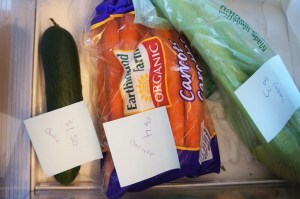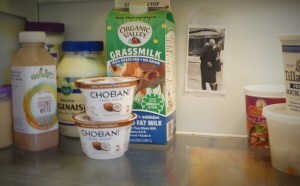How to Avoid Wasting Food
A couple of years ago, comedian John Oliver took to task the issue of food waste on an episode of This Week Tonight. It’s a great primer on a serious problem.
I find that my diligence on wasting food waned in the past year. At the start of the pandemic, I panic-shopped and bought too much. I did all I could to avoid tossing anything, in part because I wanted to limit how often I had to go to the store to buy anything. In the past months, though, I’ve found myself getting lax. When I cleaned out the fridge yesterday, I was a bit shocked at how much I tossed into the bin. I cleaned out my freezer and, quelle horror, I found an entire stash of hamburger from March 2020. WTH? (Although, experts say it is still fine to eat.)
So I watched Oliver’s story again. I dedicated myself to eating everything in our freezer.
I dedicated an entire chapter of my 2011 book, The Kitchen Counter Cooking School, to the issue of food waste. Here’s an excerpt from my chapter titled “Waste Not, Want Not,” courtesy Viking/Penguin Random House:
“Even as they bemoan food prices, American consumers are generally unaware that they spend the smallest percentage of their wages on food than any other country in the world; just above 10 percent of paychecks go toward putting food on the table. Compare that to 1900, when 40 percent of wages went toward food. Around 1960, the first time the amount spent on food was no longer the biggest expenditure, we spent about 25 percent.
The declining cost comes with the rise industrialization of farming practices and the shift of everything we eat – from pigs to cows to orange juice –into mass-produced merchandise.
Perhaps it’s the lack of investment that leads to a cavalier attitude toward food. We may give thanks for our bounty once a year, but then as a country we collectively waste about 40 percent of the food produced for consumption the rest of the time.
Anthropologist Timothy Jones spent more than a decade studying food wastes. His research finds that some crops sit abandoned or unharvested in the field where it’s grown. Supermarkets or suppliers discard another few percent dismissed as too imperfect for retail. The rest – about 25 to 30 percent –we throw away at home.
That food goes into landfills to rot where they emit clouds of methane, a greenhouse gas more toxic and damaging than carbon monoxide.
“By treating edibles as a disposable commodity, we teach our children not to value food,” says Jonathan Bloom, author of the book, Wasted Food: How America Wastes Nearly Half of its Food (and What We Can Do About It). He puts the figure on what we waste at more than $100 billion annually.
This jived with what I found in the interviews with the volunteers and the kitchen visits, and what I observed in my own house and in the homes of friends. A few of the volunteers agreed to keep a journal of what they bought, ate and threw out for two weeks. The result? They reported less waste due to the guilt they felt knowing they had to write it down, but even then, an average of 18 percent of their groceries bill went into the trash.
But why do we waste so much? Both Jones and Bloom offer some interesting insights.
First, people often shop for their aspirational life, not their real one. Everyone knows that you’re supposed to eat fruit and vegetables, so we stock up on perishables. But that leads into the second problem. Since most people don’t plan meals for the week, those beets or greens that looked so great at the farmer’s market sit untouched, as we end up eating convenience foods.
With proper planning, buying in bulk or loading up on two-for-one deals can be a genuine money saver; without a plan, it’s just a recipe to double or triple the amount of food tossed away.
Here are some strategies on how to avoid wasting food:
 These veggies represent $8.50 in post-tax income
These veggies represent $8.50 in post-tax income-> The Post-It Note Trick: When you bring food home from the grocery store, put a post-it note on each perishable item with the amount it cost. No one would throw $5 into the trash, but wasted food is also wasted money. When you do toss that food without eating it, put those post-its in one place. At the end of the month, total up how much you tossed. The first time I tried this, I realized I had wasted $114 in food.
-> Take an Inventory of Your Fridge and Cupboards: Empty them out. Toss the truly expired stuff. Get to know what’s in them. I even recommend making a list. Have stuff that’s been around for a long time that you’ll never use? Or four jars of paprika? Donate excess stuff to a food bank. Start to research recipes to use up the stuff that’s been languishing. I just did this. It was a motley array from anchovies to udon. Why so many cans of pineapples and tomatoes? Ah, that Costco trip! Damn it.
-> Eat Down Your Fridge and Freezer: This challenge was developed by food writer friend, Kim O’Donnel. It’s pretty simple: Skip at least one shopping trip a month and try to use up your remnant food instead. I am dedicating the next month to eating all that frozen pandemic beef.
 Our fridge, with a photo of Mike and I kissing in Paris.
Our fridge, with a photo of Mike and I kissing in Paris.-> The Photo In the Back of the Fridge trick: Chef Thierry Rautureau of Seattle suggests putting a favorite photo in the back of your refrigerator. “If you can’t see it, your fridge is too full.”
-> Shop more often, buy less: Buy one pepper, not three. Buy three potatoes, not three pounds. Says Chef Rautureau: “If you have less food in your fridge it will actually push you as a cook. You will have to make something different. It will force substitutions. You think, ‘I don’t have a green pepper but, oh wait, I have a zucchini so I will try that.’ It’s a good thing. That’s how you learn.”
-> Don’t give up on food too easily: Apple has a dent in it? Cut it out and use the rest of the apple. If a few leaves of lettuce go brown, pluck them out, don’t chuck the whole bag.
-> Learn to make soup: Check out my “How to Make Soup out of Anything” guide. Soup is basically sauteing a half onion, adding chopped up leftover vegetables, some water and stock and simmering it for an hour.
-> When a jar of jam, mustard or peanut butter is nearly empty, use it to make vinaigrette: Seriously, this is a great trick. Watch the video here.
-> Home-style Individually Quick Frozen (IQF): This is a super easy way to preserve almost any vegetable or fruit. I do it all the time with berries. Spread them on a tray, freeze, and when frozen solid, put them into a plastic bag. In January, you can pull out a handful onto your pancakes, or add to a morning smoothie.
Learn a few super flexible recipes to use up common leftovers, such as:
-> Stir-fried rice – I use this version from Simply Recipes way to use up leftover rice and random vegetables
-> Omelets – Another simple way to create a new meal with a couple of eggs and leftovers. Watch Jamie Oliver in this video lesson
-> Quesadillas – My husband will eat almost anything taste good stuck between two tortillas with some cheese
ALSO
> Follow Jonathan Bloom’s excellent blog, Wasted Food: Get his newsletter or an RSI feed, follow him on Twitter. Keep this issue top of mind.> Order the classic book, More With Less by Doris Longacre: Written for the Mennonite Church, this book offers all kinds of suggestions for menu planning, shopping and rethinking how we consume in this world of such intense consumerism.Longacre’s book taught me a lot about how to stop wasting food. As Oliver notes, we don’t need all-you-can eat ribs or “endless shrimp buffets” in a country that not only wastes so much food but also has the dual issues of obesity (about 35% of Americans are morbidly obese) while nearly one-in-six children go hungry.
Do you have any suggestions or strategies for wasting less food? Let me know.
This post may contain affiliate links. It was originally published in 2015. It has been updated.
The post How to Avoid Wasting Food appeared first on Kathleen Flinn.



